
Hunger Report
Insights on food insecurity, inequity, and inclusive recovery in the Greater Washington region
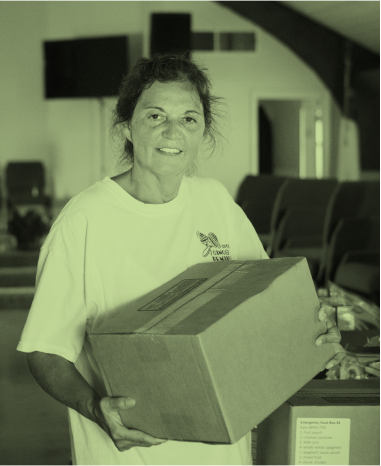

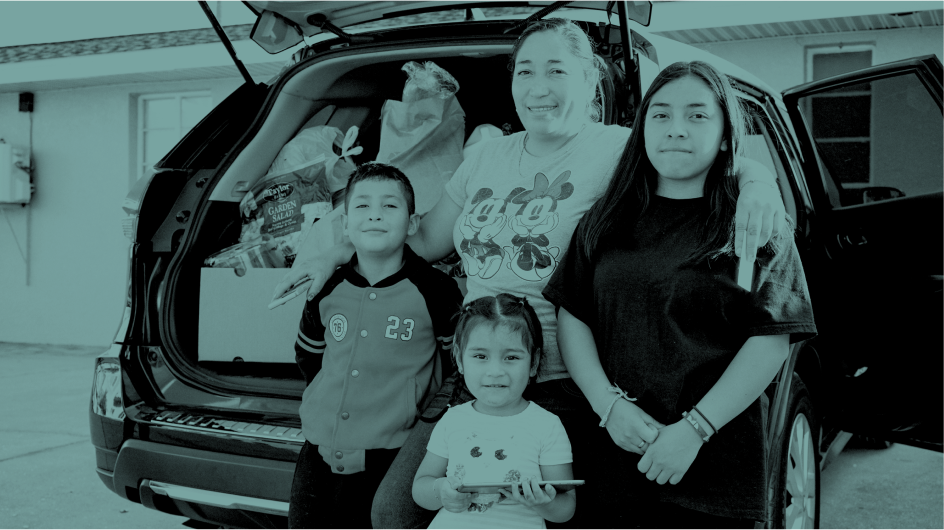

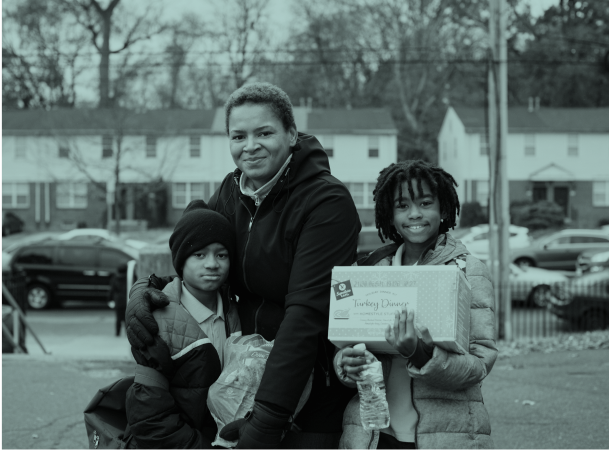



Foreword
More than two years out from COVID-19’s arrival in the United States, the story of the pandemic has proven to be a long and evolving one. When last year’s report was published, our area seemed poised for a gradual return to more normal life. But as we now know, the subsequent emergence of multiple variants, and the resulting spate of closures and renewed restrictions, caused a fresh wave of medical and financial difficulties for people across our region and beyond, compounding the hardships so many were already facing.
Accordingly, the need for food assistance has remained extremely elevated. Last year, the Capital Area Food Bank distributed more than 64 million meals—a higher number than any single calendar year in its history, and more than double the levels of 2019. Today, in the face of rising inflation and ongoing shifts in the global economy that continue to affect many people, that need is not abating.
In response to continuing events, we wanted to develop a clear picture of the current scope of food insecurity and poverty across our region, and to further deepen our understanding of whom it’s affecting, in what ways, and what this means for the future. We also wanted to widen the aperture on the data collection and analysis performed in previous studies to include sentiments around key social and economic issues facing our region, as well as individual expectations about recovery. And we wanted to assess all of this information in the context of the wider community’s experiences.
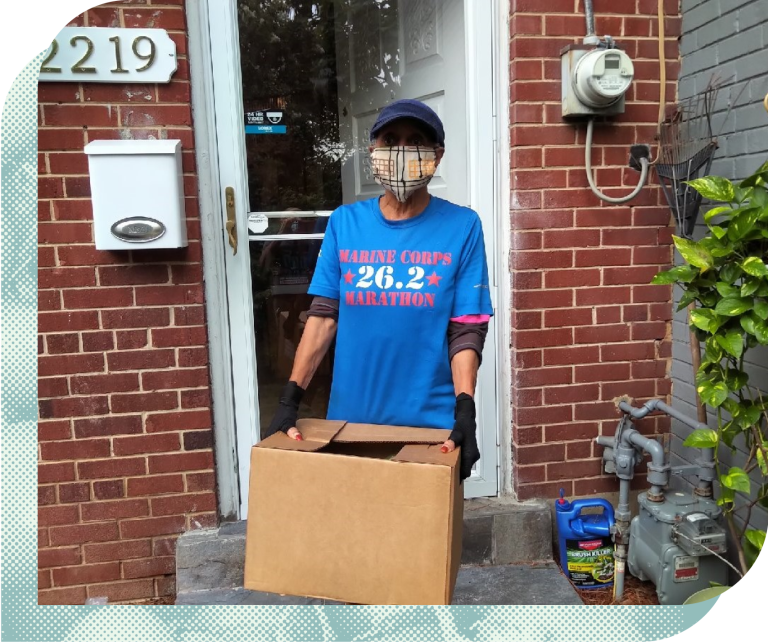
To accomplish these aims, we joined forces with NORC at the University of Chicago, one of the largest and most trusted independent social research organizations in the United States. The result of this new partnership is a first-of-its-kind general population survey about food insecurity and inequity in the region, reaching nearly 4,000 residents. General population surveys are the most reliable and accurate tools available for understanding the prevalence of key concerns and opinions in the context of broader society.
The survey results contained in this report are extraordinarily illuminating. They provide a snapshot of the levels of food insecurity in our region over the last year, which were breathtaking even to those within the food bank who work most closely on these issues. In some counties in our region, nearly half of all residents experienced food insecurity at some point in 2021. Even in the areas with the lowest prevalence, that number is over 20%.
The survey’s results also bring many of the known correlations between food insecurity, race, educational attainment, and geography into stark relief, placing an even brighter spotlight on the longstanding impacts of systemic racism and structural inequities across our area.
The imperative is clear: as we rebuild our region, we must do so in inclusive ways that enable more people to participate in recovery.
What is evident in this year’s new data is how profoundly different the experiences of the pandemic have been for people across our region. Household incomes have gone down separate paths since March 2020, with about a third earning less than two years ago, a third earning more, and a third earning about the same. Residents’ future outlooks are similarly fragmented. About half expect their income will remain flat over the next year, but 1 in 5 expect their income to get worse.
The variations in these financial trajectories signal a pronounced worsening of the disparities in our economy. Although those disparities existed before the pandemic, the data underscore that the events of recent years have set these trend lines on a course for continued divergence. This will have negative consequences for all of our region’s residents—not just those who are experiencing hardship.
The imperative is clear: as we rebuild our region, we must do so in inclusive ways that enable more people to participate in recovery. Accordingly, the final section of this report provides recommendations for—and examples of—policies and practices that can help keep existing divides from growing wider, and even help narrow them from pre-pandemic levels. Collectively, across all sectors, a once-in-a-generation moment exists to drive a recovery that benefits all members of our community, creates more opportunity for more people, and shrinks the equity gap across our region and beyond. Now is the time to seize that chance.
Key Terms
DMV (or Greater Washington Area)
The DMV, short for DC-Maryland-Virginia, refers to the Washington, DC metropolitan area and includes the following jurisdictions: the District of Columbia; Montgomery and Prince George’s Counties in MD; Fairfax, Arlington, and Prince William Counties in VA; and Alexandria City, VA. (Within Fairfax County are included Fairfax City and Falls Church City. Within Prince William County are included Manassas City and Manassas Park City.)
Inclusive economic recovery
An economic recovery from the COVID-19 pandemic that is inclusive of all residents in the DMV inherently addresses the disproportionate impact of the pandemic on certain populations—people and communities of color, low-wage earners, women, and households with children. Inclusive recovery strategies are aimed at closing the gaps of pre-existing disparities in our region, rather than perpetuating or widening them, and at increasing opportunities for all residents to benefit from and contribute to local economic prosperity.
Food insecurity
Food insecurity, as defined by the USDA, is “a lack of consistent access to enough food for an active, healthy life.” Individuals who are referred to as food insecure in the report were identified, using the USDA’s standard six-question screener, as having experienced one or more food-related hardships at any point during the past year. The screener is used to identify three levels of food security: food secure, food insecure, and severely food insecure.
Inequity
For the purposes of this report, inequity refers to an uneven distribution of resources or opportunity relative to need. Unlike “inequality,” which assumes all people should receive equal shares of support from the systems around them, the term “inequity” assumes that systems should work in favor of those starting with lower resources and opportunity, not against them.
Hunger
Hunger is a physical symptom of a lack of adequate food. It is not a quantifiable term, but rather a description of the result that reducing one’s food intake can have. Hunger and food insecurity are not synonymous, though they are closely related.
Low-income
There are many legitimate thresholds and formulas by which this phrase is defined, but in this report, it refers to respondents to the 2022 CAFB survey who reported a household income up to the 33rd percentile for their local county or city, i.e., the lowest third.
Warning: Trying to access array offset on value of type bool in /nas/content/live/cafbhungerrepo/wp-content/themes/cafb-hunger-report-theme/partials/report-section-loop-2022.php on line 4
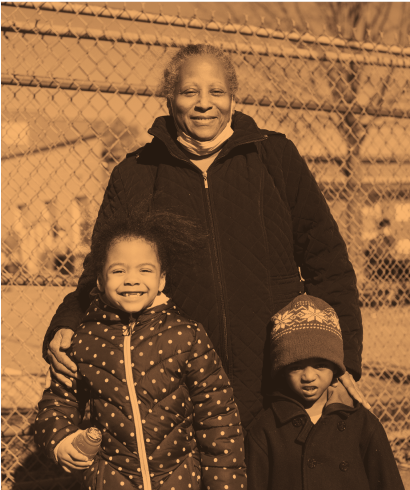

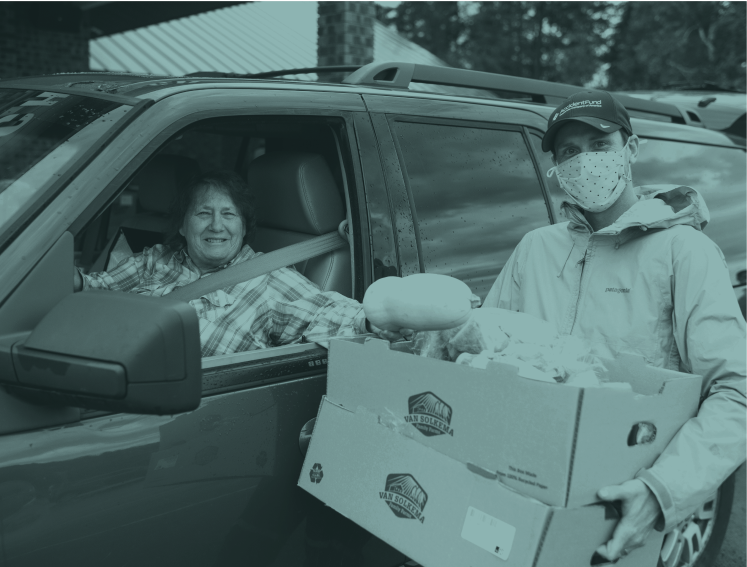
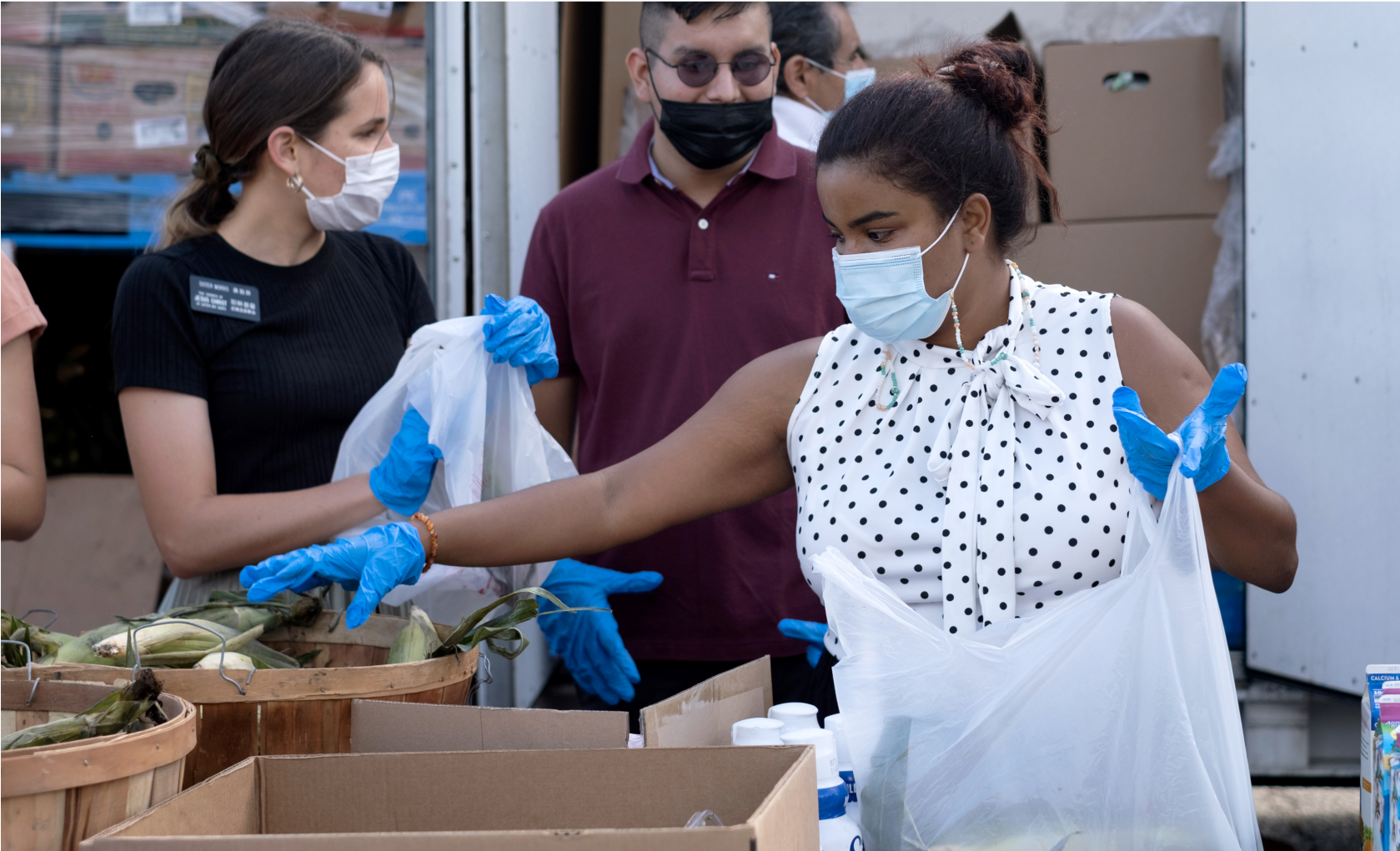
A Current Look at Food Insecurity
While the pandemic’s severity has periodically increased and decreased, its negative economic impacts have remained constant for many in our region. In the second year of COVID-19, the prolonged effects of job loss or unsteady employment, strained or depleted savings, curtailment of certain pandemic-era government benefits, and other contributors to financial instability continued to mount.
The results of CAFB’s survey reflect the toll that these forces have taken on our region’s food security. The data contain insights into the current demographics of those who are struggling to put food on the table, and how they compare to those who have not experienced food insecurity in the last year. They reveal known, persistent trends driven by structural inequities, along with several surprising findings that raise important questions. And they exhibit the ongoing financial challenges many in our region have experienced as a result of the pandemic, as well as the increasingly divergent paths on the horizon for members of our community.
Regional Levels of Food Insecurity
Among the most significant findings in the survey data was the sheer prevalence of food insecurity across the region in the second year of the pandemic. The survey employed the USDA’s standard screener for food insecurity and found that within the general population, 33% —one-third of people— had experienced some level of food insecurity during the year prior.
One-third of people experienced some level of food insecurity during the year prior.
The survey was designed to test for varying degrees of food insecurity and defined its severity in the population over three tiers, correlated with the frequency of experiences such as skipping meals or eating less than desired due to a shortage of financial resources available for food. Among food insecure respondents, half were classified as “severely food insecure,” the most acute tier.
The significance of these data cannot be overstated. For individuals, uncertain and inadequate access to food can have impacts that include reduced productivity, poorer health, lower educational performance, and many other outcomes that impede quality of life and access to future opportunities. The implications when fully one-third of a region’s population is impacted by hunger, therefore, are profound.
Salanda is the mother of two sons with learning disabilities and significant autoimmune conditions. Government assistance programs enable her to access the foods that help manage her family’s health, but during the pandemic, this became much more difficult.
The survey’s findings are also representative of food insecurity at the county level. Here, we see even starker realities: in some counties, like Prince George’s County, MD, food insecurity has affected 48% of the population. In Prince William County, VA and Washington DC, the prevalence rate was 36%.
View More County-Level Survey Data
This year’s report contains the first information to be released about rates of food insecurity in the Greater Washington region over the past year. These findings, which have been verified and validated multiple times by our research partner, clearly show a markedly higher prevalence of regional food insecurity than any other known data on this subject in recent history. This is despite the fact that these findings potentially underrepresent the prevalence of food insecurity, given the survey was only administered among the housed population and did not reach thousands of unhoused individuals in the region.
Due to differences in methodology, it must be noted that these data cannot be directly compared to previous studies or models on regional food insecurity. Through its partnership with NORC, however, the food bank will administer this survey on an ongoing basis in future years, creating a body of research that can be used to explore trends over time.
Insights About Those Experiencing Food Insecurity in Our Region
A closer examination of food insecurity data in our region—including demographic and employment data about those experiencing it—reveals a range of insights. Some underscore well-documented trends and correlations, while others run counter to common narratives. All highlight various dimensions of the deep and long-standing inequities that have characterized the Washington region since well before the pandemic, many of which have been covered extensively in prior Hunger Reports.
Food insecurity has significantly unequal impacts on communities of color
Respondents experiencing food insecurity were disproportionately from communities of color. The prevalence of food insecurity among those who identified as Hispanic was 55%, and 50% among those who identified as Black. By contrast, the prevalence of food insecurity was only 13% among the survey’s respondents who identified as white. The disparate impacts of food insecurity on people of color are well documented, and long predate COVID-19.
As noted in previous Hunger Reports, in observing the correlation between race and food insecurity, we must directly acknowledge the roles that systemic and structural racism—both historical and in present-day systems—play as drivers of the inequity in our region. Longstanding and ongoing discriminatory practices in employment, education, housing, lending, municipal planning, and many other areas regularly affect communities of color in ways that contribute to the higher rates of food insecurity among these groups.
Households with children are twice as likely to be affected by food insecurity
Survey results revealed that 49% of all households with children across the region experienced food insecurity at some point during the last year, as opposed to only 25% of households without children.
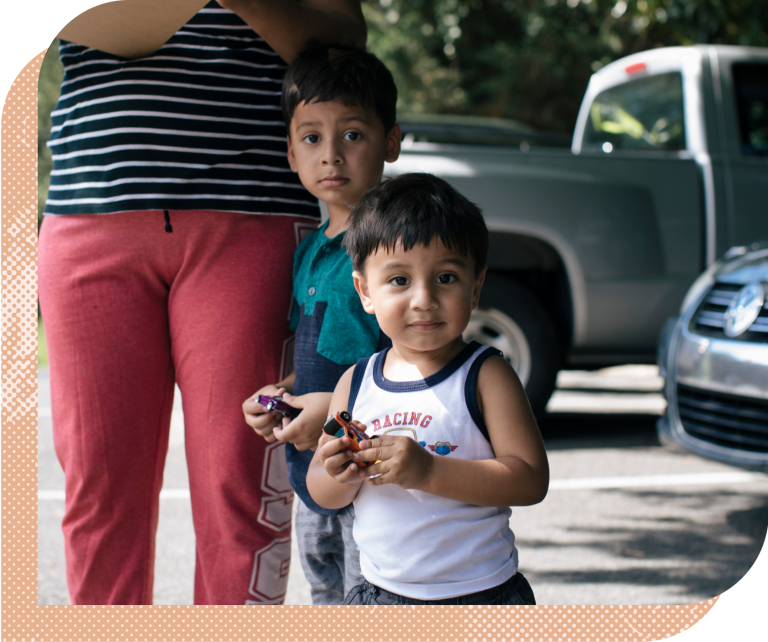
Households with young people have long been overrepresented among those served by the food bank. For parents and grandparents raising children and young adults in a region with a high cost of living, budgets can easily become stretched, and data tell us that when resources are tight, food is frequently one of the first things to be cut back. The prevalence of food insecurity among families with young people became even more pronounced during the COVID-19 pandemic, when more area households than any time in recent history were thrust into economic hardship.
Combining the factors above results in exponentially higher rates of food insecurity
As with many other socioeconomic trends, multiple, stacked disadvantages can compound negative food security outcomes. Given that two of the strongest indicators for food insecurity were race and presence of children in the household, we analyzed the intersectionality of these factors and found extremely disparate prevalence rates.
Compared to only 12% of white households without children, nearly two-thirds (61%) of non-white households with children experienced food insecurity over the last year. This dramatic contrast speaks to the gulf in experiences for different households across our region.
Nearly two-thirds (61%) of non-white households with children experienced food insecurity over the last year.
There is a higher prevalence of food insecurity among those with lower educational attainment
Food insecurity was also highly correlated with lower educational attainment. Among those who screened positive for food insecurity, 11% had less than a high school degree. 36% of respondents—the largest percentage within this group—had a high school degree or the equivalent. 28% had some college, and 25% had a college degree or above.
By contrast, only 1% of food secure respondents had less than a high school degree. 16% had a high school degree, and 19% had some college education. Fully 64% of respondents had a college degree or higher.
This is perhaps unsurprising, given the correlation between educational attainment and earning potential. As with food insecurity’s impacts on communicates of color, its prevalence among those with lower educational attainment rates pre-dates the pandemic and is connected to many of the same systemic barriers noted in the section above.
Young adults are overrepresented within the adult food insecure population
Young adults ages 18–29 made up 31% of the population experiencing food insecurity, despite totaling 21% of the general population. This was almost twice as large as the percentage of individuals in that age cohort within the food secure population.
While hunger affects a large number of households with children under age 18, as noted above, food insecure young adults are also particularly vulnerable. Many young adults are low earners, young parents, and/or students, making them financially insecure. These young adults have also often “aged out” of many of the social welfare benefits that support children through age 17, and food relief programs that assume the ability to store and prepare food may not meet the needs of this group as effectively.
The prevalence of hunger among young adults also correlates with a separate assessment of food security among young people in the Washington region that the food bank recently conducted. In that assessment, young people ages 18–24 made up the largest group of food insecure individuals within the 0–24 age set, indicating this population for continued study and focus.
Employment rates are essentially equal between the food insecure and the food secure
One finding within the survey data that may be surprising to many is the relative percentages of people who were employed within food insecure and food secure groups. 77% of people facing food insecurity were employed, compared to 74% of those who did not experience food insecurity.
The nearly identical rates of employment between these groups, with a slightly higher level among those facing food insecurity, may speak to the quality of employment and level of wages available. For individuals working low-wage jobs—often several at a time—the high cost of living in the area may mean paychecks are not enough to cover housing, transportation, and medical expenses, while still having adequate funds for food. Over the course of the pandemic, individuals whose hours have been severely cut, even if they remain employed, may still experience hardship.
The Widening Financial Trajectories of Low- and High-Income Earners
The disparate financial impacts of the pandemic across different groups, particularly those on the higher and lower ends of the socioeconomic spectrum, are by now well known. In last year’s report, we highlighted the divergent employment trends of different levels of wage earners. One year later, the data show a deepening divide: Employment rates are still 15% lower for those who work in low-wage jobs, while employment rates for those who work in middle- and high-wage jobs have essentially returned to their pre-pandemic levels.
The survey results underscore that those who were already struggling were harder-hit: food insecure households were at least twice as likely as those who are food secure to experience some type of employment hardship—including reduced hours, reduced wages, or being laid off—because of the pandemic.
Staci experienced food insecurity for the first time during the pandemic after losing her job as an activities coordinator for senior living facilities due to COVID-19 restrictions. She is still looking for work.
These employment hardships have translated into broader financial hardship. 44% of food insecure adults were unable to pay a credit card bill at some point since March 2020, compared to only 9% of food secure adults. Similarly, 42% of food insecure households were unable to make rent or mortgage at some point since March 2020, compared to only 4% of food secure households. Food insecure adults have not been able to pay down debt or save money during the pandemic at rates as high as food secure adults.
Nearly half of food-insecure adults said their household income is lower now than it was in March 2020.
Perhaps most notably in the immediate term, the pandemic is having a marked and ongoing impact on the earning power of food insecure households. Among food insecure adults, nearly half said that their household income is lower than what it was in March 2020, while only 18% of food secure adults said the same. This indicates that economic recovery for those hit hardest financially by the pandemic is lagging well behind those who were less impacted.
Even if this income drop is short-term, it could result in permanent economic disadvantage, given the lower point from which individuals with reduced incomes are starting recovery.
While these economic challenges have been brought about by the pandemic, the ramifications are set to far outlast it. Defaulting on rent, mortgage, and credit card payments in the short term, for instance, can have negative consequences for credit and borrowing capacity that extend well into the future. Similarly, a debt burden or an inability to save can impact family finances for years, and ultimately generations, by preventing the accumulation and transferal of wealth.
An uneven pandemic recovery that reinforces the existing systems and structures that advantage some members of our community more than others will ultimately be slower, and it will prevent the Washington area from reaching its full potential. For the benefit of everyone in our region, now is the moment to enact new strategies—across every sector—to address food security and its underlying inequities and create more opportunity for more people.
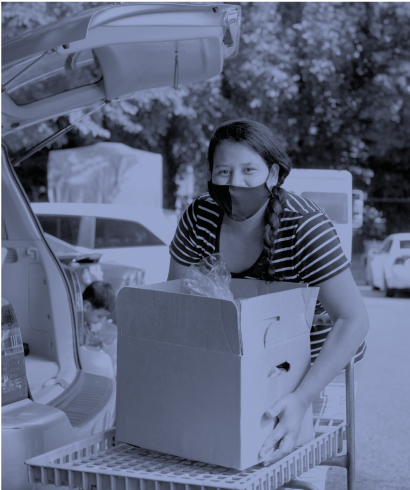

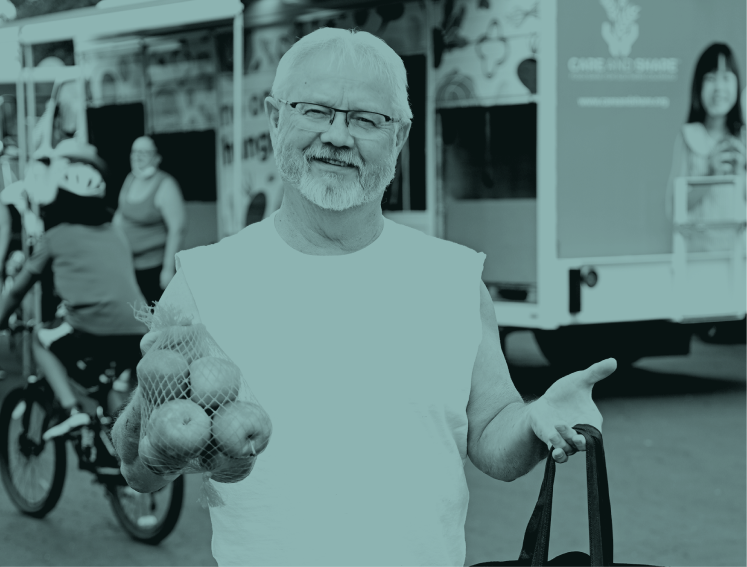
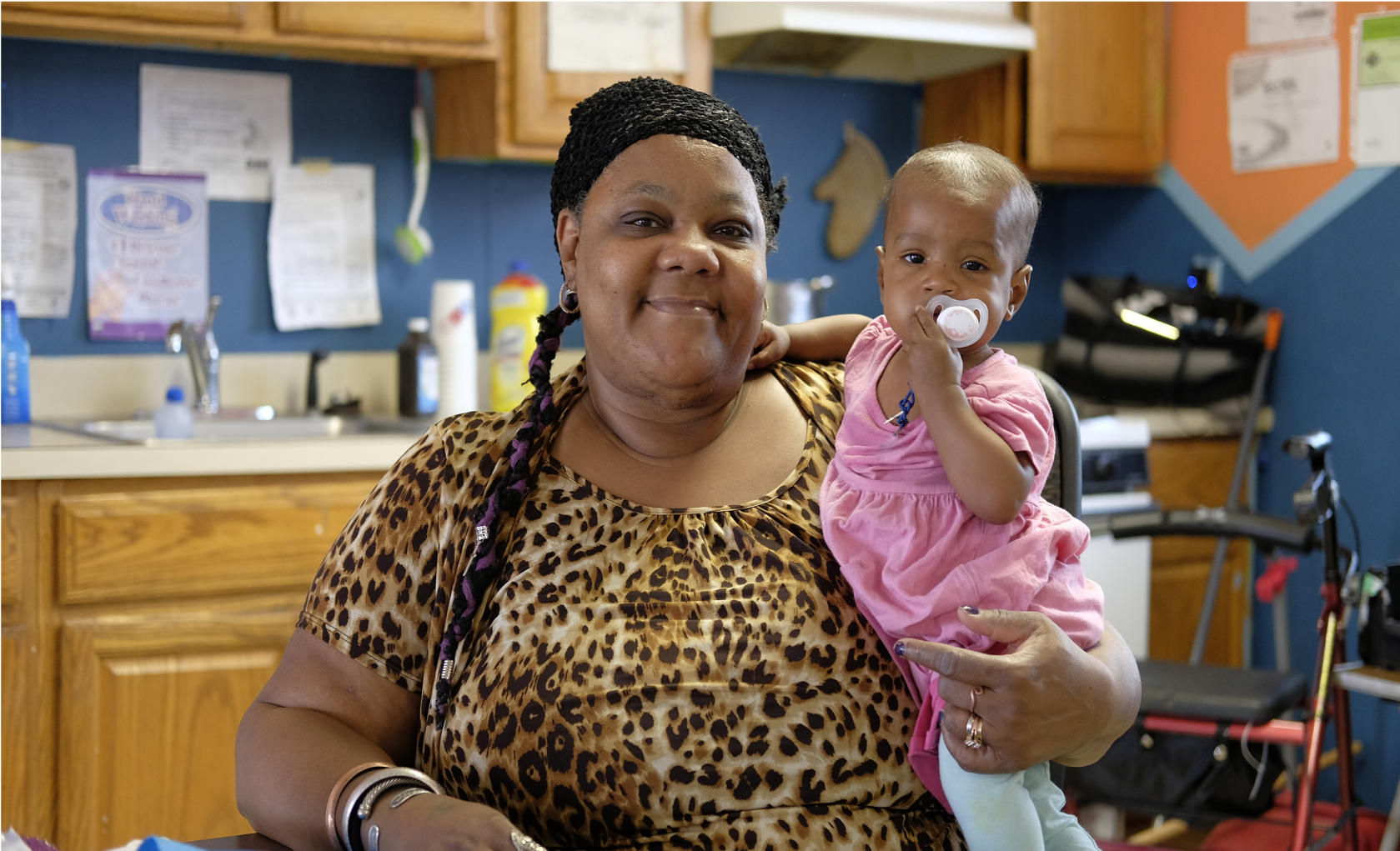
Perceptions of Recovery and Inequity
The data presented above—along with large volumes of other research and reporting—make plain that various subpopulations of the DMV have experienced the events of the last two years differently. While some have come out of this period relatively economically unscathed (or perhaps even better off), others have lost nearly everything—and much of this diverges along racial lines. As we consider what an inclusive, equitable recovery from the pandemic should look like, the opinions of those most affected must play a critical role.
While data is always a central element of the Capital Area Food Bank’s strategy for addressing food insecurity in our region, the perceptions and experiences of our clients are equally vital. Solutions to socioeconomic challenges are stronger when they’re grounded in the lived experiences of those closest to the issue, which is why a section of this report is dedicated to the perceptions and opinions of those in our region who are experiencing food insecurity. Their insights on issues such as economic recovery, racial inequity, and food insecurity are invaluable as we seek to identify and co-create solutions.

Low expectations for “recovery”
Since the beginning of the COVID-19 pandemic more than two years ago, the Capital Area Food Bank has joined many other voices in warning that the first- and hardest-hit would be the last to recover. By now, it is widely known that lower-income people and people of color experienced the worst economic impacts of the pandemic. But it is increasingly clear that these variances will extend to economic recovery as well. In addition to the fact that most data point to widening gaps between higher- and lower-income individuals, the beliefs and expectations of these groups suggest that recovery is not coming quickly. This combination of data and individual expectations paints a clear and worrisome picture of the future for our region if greater collective efforts to address the trends are not taken.
Beverly relies on disability and monthly support from CAFB nonprofit partner Manna to meet her food needs. Stretching her resources helped her get through quarantine early in the pandemic, but amid rising costs, she is preparing for continued financial challenges.
When asked about their own projections of whether their household finances would improve or worsen over the next year, most people in the DMV are not very optimistic. Two-thirds expect that their household finances will either stay the same or get worse. However, respondents who are experiencing food insecurity are more than twice as likely as food secure individuals to indicate that they expect their household finances to decline over the next year. Similar disparities exist between white and non-white respondents, and between higher- and lower-income respondents.
Interestingly, this pessimism was more closely correlated with food insecurity than almost anything else. People experiencing food insecurity were more pessimistic about recovery than any other group of people surveyed—people of color, unemployed individuals, lower-income households, young adults, older adults, etc.—apart from those without a high school diploma. In addition to the obvious impacts of prolonged food insecurity on physical and mental health, this elevated level of pessimism is likely based in large part on the prolonged impacts of unemployment and underemployment on this population. Besides experiencing these impacts at higher rates, 71% of food insecure individuals reported that pandemic-induced changes to their household’s job situation are having a major impact on their financial situation, compared to only 27% of food secure individuals.
While these statistics represent individual expectations about recovery, not economic projections, the implication is still distressing. If these expectations were extrapolated across the entire DMV, 28% of food insecure adults would experience a negative recovery, finding themselves even worse off financially than they are today. This is not implausible, given the abundance of data suggesting that household finances are still declining for many.
Diverse perceptions of inequity
The fact of inequity in our region is plain. Disparities in health, education, employment, incarceration, and myriad other outcomes between different groups are staggering. Perceptions of these inequities, however, are another matter.
Coverage of growing inequalities in the U.S. has expanded significantly as a result of the pandemic, with this subject now close to common knowledge. Unsurprisingly, most adults currently agree that inequalities in the D.C. metro area are a major problem and that the pandemic has made these inequalities worse. However, a closer look at how different groups responded to these questions reveals interesting trends, and even a hint of optimism that the pandemic has helped bring some much-needed attention to these issues.
Shavanah is an undocumented college student working multiple jobs as she goes to school. Living with her mother (an essential worker), and her sister (a server who lost her job in the early days of COVID-19), she has seen firsthand the disparate impacts of the pandemic.
When respondents were asked whether they felt inequalities between high- and low-income people in the D.C. metro area were a major problem, minor problem, or not a problem at all, different racial groups had different perspectives on the issue. When asked the same question, but about inequalities between white people and people of color, these differences were even further pronounced. While the majority of respondents in nearly all categories agree that these inequalities are a problem, the disparity of opinion between different racial groups about racial inequalities reinforces the broader understanding that race has had a significant influence on individuals’ experiences of inequality.
Another question in the survey focused on how the pandemic has changed the landscape of inequalities in the region. As noted above, most respondents believe that the pandemic has made these inequalities worse—and the data support this fact. However, a noteworthy contingent of Black and Hispanic respondents believe that the pandemic has decreased inequalities between high- and low-income individuals, as well as between white people and people of color.
Without qualitative research, the rationale for this belief can only be speculated upon. One potential explanation, however, is that the economic and social supports offered in response to the pandemic were perceived to help level off some pre-existing inequalities. While this is a promising sentiment and suggests that pandemic-era socioeconomic interventions may be effective for reducing racial inequalities, this topic requires further research.
Underestimating the problem of food insecurity
To assess the public’s views on various social and economic issues affecting the region, the Capital Area Food Bank asked about the importance of each of the following issues: food insecurity and hunger, education, crime, unemployment and jobs, homelessness, inflation, poverty, and race relations. While most adults consider all of these issues to be very important, a few interesting trends emerge from the data.
First, only 54% of respondents think food insecurity is currently a major problem in the D.C. metro area—with another 36% considering it to be a minor issue and 9% believing it not to be a problem at all. Although a third of our region did not know where their next meal would be coming from at some point during the last year, survey respondents were more likely to consider food insecurity to be a major issue in other parts of the United States versus in the DMV (65% vs. 54%). This indicates low awareness of the extent of the problem in our own region.
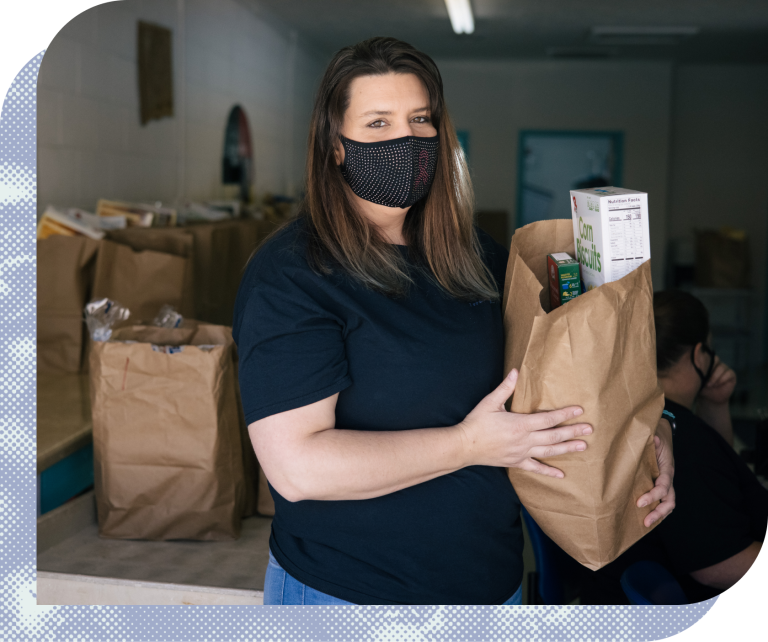
Second, food insecure respondents were more likely than those who are food secure to consider various socioeconomic issues to be very or extremely important, with disparities ranging from 10 to 30 percentage points. Within these, the largest differences in opinion were around the issues of unemployment and jobs, food insecurity and hunger, homelessness, and poverty—the issues that affect the food insecure population most directly. These wide gaps in perceived importance point to the disparate realities that different segments of the population experience and underscore the value of centering the voices of those most directly impacted by these issues when designing initiatives to meet their needs.
The survey also asked about how food insecurity has been addressed over the course of the pandemic and whether the response of different types of actors has been sufficient. Interestingly, while most adults agree that governments of all levels bear the greatest responsibility for addressing food insecurity in the United States, nonprofit organizations are seen as the entities that do most to address food insecurity. There are no significant differences between food secure and food insecure adults on this issue.
…being under the poverty level, it's a constant stressor, not knowing what tomorrow might bring, or am I going to make it through the month with a little bit of means that I have.
In looking at these snapshots of public opinion together, there are two angles from which to view the data: one promising and the other concerning. On one hand, there is an encouraging display of agreement around our region’s pressing issues, such as inequality, education, crime, inflation, and race relations. Most people consider these to be major, important issues. On the other hand, many of these same questions on the survey revealed significantly varying opinions of key issues such as poverty, homelessness, food insecurity, and unemployment, as well as divergent expectations about recovery from the pandemic.
Food insecurity was a major factor driving these differences, which suggests that individuals who are not experiencing these issues are less likely to consider them significant. Ultimately, each of these is a major issue, and they are all deeply intertwined. When people are food insecure for long periods of time, their ability to maintain their health, support strong relationships, and perform at work or school suffers. Multiplied across thousands of households, this creates ripple effects through our region’s education systems, employment rates, homelessness, and patterns of inequity.
To address these issues most effectively, change needs to be shaped by those experiencing these problems, and interventions must be simultaneously directed at as many aspects of the issue as possible. The final section of this report is dedicated to surfacing key recommendations for public, private, and social sector actors who are committed to addressing these issues.




Recommendations for Inclusive Recovery
The impacts of food insecurity and the inequities that drive it extend broadly across our region and touch every sector. Strategies for addressing these problems, therefore, must be similarly far-reaching. Importantly, they must also be complementary and highly collaborative. There are many initiatives already underway in our region to aid equitable economic recovery and support paths to opportunity. The ultimate ability of these initiatives to reach their intended audiences and fulfill their potential to make change will require thoughtful partnerships, both within and across private, public, and nonprofit entities.
The below section recommends several strategies for each of those categories. Some have been discussed in prior reports and are covered again here to underscore the consistency of the issues underlying food security and the importance of approaching this challenge holistically. The recommendations and actions highlighted are informed by many sources, including the results of recent and past surveys, case studies, literature reviews, and consultations with partners across each sector. Most essentially, they center the needs and voices of our clients. Combined, these recommendations have the power to positively impact our neighbors both in the immediate term, and over the months and years to come.
Private Sector
As noted earlier in the report, CAFB’s survey found that residents of the DMV view businesses as both having the least responsibility and doing the least to help the problem of food insecurity, compared to the public and social sectors. However, many of the most powerful levers for reducing inequity and driving inclusive recovery are within the control of businesses. Specifically, companies have incredible influence over the problem of food insecurity and other socioeconomic challenges through their employment strategies.
Indeed, a wave of businesses is using this influence to promote greater equity in our region by offering higher-quality jobs to their frontline workers. These moves are laudable and should be replicated by more companies. Yet the findings of CAFB’s study indicate there is still a major gap in the availability of or access to these opportunities: The data show that over half of food insecure adults would experience a major positive impact on their household finances from gaining access to higher-quality jobs.

There are many elements of a job that define its quality (see the Urban Institute’s definition of good jobs for a comprehensive framework), but the recommendations in this section focus on the aspects of employment that stood out in the survey: higher wages, paid leave, and greater opportunities for upward mobility.
Pay living wages
In Greater Washington, low-wage workers represent about a third of the workforce. These individuals are mostly in their prime working years (ages 25–50), are likely to be raising children, and are often facing economic hardship, according to a study by the Brookings Institute on the characteristics of low-wage workers. Women and people of color are overrepresented among low-wage workers, a driving factor of the inequity trends we see across our region. The wages collected by this subset of the labor force fall somewhere between the minimum wage and a living wage, which is the amount of income that could support a modest standard of living in a particular location given costs of housing, transportation, and other needs.
For many years, research has shown that when companies pay low wages, businesses and employees suffer, because workers are unable to invest in growing their skills and employers are constantly paying the high price of managing an unstable workforce. Conversely, paying a living wage is good for businesses, as it reduces employee turnover, attracts more qualified workers, increases productivity and morale, and creates a more desirable marketplace. In fact, companies that paid a living wage through the pandemic fared better in recovery than those that didn’t.
Offer paid leave
Another practice that benefits businesses is providing paid sick time and paid family and medical leave to employees. Low-wage workers without paid leave have very little flexibility to absorb the shock of common life events such as the birth of a child or the illness of a family member, which leads to disproportionate loss of income, loss of employment, and physical and mental health consequences when these events take place.

Providing paid leave, especially for low-wage workers, is not only proven to improve economic security for workers and families; it also benefits businesses’ bottom lines through reduced turnover costs and helps the economy overall. And businesses are catching on: recent studies indicate that support for paid family leave programs has been increasing in recent years, even among the smallest businesses.
Invest in upward mobility for employees
The third recommendation for the private sector is to invest in upward mobility for low-wage earners. Many workers in low-wage jobs become trapped in a cycle of low-wage work, in part because the pathways to high-wage work are unclear and full of hurdles. A recent study by the Harvard Business School suggests that several tactics, ranging from hard and soft support for employees to bottom-up business strategies, can facilitate company success while helping more low-wage workers transition out of the cycle of underemployment. These recommendations include rewarding and measuring retention, offering paid training and skill development, providing low-wage employees clarity around how to get promoted, training managers on how to mentor and support their employees, and partnering with other organizations such as community colleges to build the local talent pool.
The evidence of these strategies’ positive returns for businesses is overwhelming. These practices can help lift thousands of low-wage workers out of the cycle of poverty and underemployment, while also producing significant ripple effects through the entire regional economy—a scenario that benefits everyone.
Partner with the social sector to enhance reach
As noted earlier, many individual corporations and collectives are already making significant investments in inclusive economic growth and greater equity in the DMV. Commitments to increase the starting wage and improve paid leave policies for the lowest-paid employees are growing, including from many corporations with major footprints in our region. Despite these trends, however, the findings from CAFB’s survey suggest that many people experiencing food insecurity in the area are not benefitting from these commitments.
This disconnect signals a need for more effective linkages between the companies who are committed to driving equity through employment and the communities who stand to benefit most from these commitments. The private sector can lean on the social sector to serve as the connective tissue between the high-quality jobs they are offering and the labor force they are hoping to reach, capitalizing on the social sector’s deep relationships and reputations as trusted institutions in these communities.
The private sector can lean on the social sector to serve as the connective tissue between the high-quality jobs they are offering and the labor force they are hoping to reach
One example of an initiative that is bridging sector gaps and bringing opportunities closer to their target demographic is NEXTversity, a partnership between local corporations, community colleges, and community-based organizations powered by Connected DMV. The program is aimed at providing lower-income community college students of color with direct exposure to the professional services industry through rotating project assignments. This approach to leveraging the various strengths and assets of each sector maximizes their impact on and reach to the communities they serve.
Public Sector
While there is a rich and worthy debate around the successes and shortcomings of the U.S. government’s response to the COVID-19 pandemic since its onset, it is inarguable that the mobilization of economic support from all levels of government represents some of the most broad-based support to lower-income individuals in American history. Expansion of social safety net programs’ eligibility and available support, financial relief to individuals and businesses, eviction and foreclosure moratoriums, and student loan forbearance are a few key examples of this response.
Nonetheless, the indications from CAFB’s study of prolonged (and, in many cases, increasing) economic hardship across our region two years into the pandemic show that opportunities for improvement remain. And the need for these reforms in the first place—particularly when it comes to eligibility for certain benefits—prove that there were lessons to be learned about designing an effective social safety net.
Helene is currently experiencing housing insecurity, food insecurity and financial stability, all of which were exacerbated by the pandemic and the rising costs of food and other necessities.
As noted earlier in this report, the public believes the government has the primary responsibility to address socioeconomic issues such as food insecurity. Based on the study’s findings about the sizable impact of program reforms during COVID-19, the core recommendations for the government are to adopt permanent reforms to the social welfare system in order to spur more inclusive economic recovery.
Enhance the reach of income-based tax credits
Tax credits are one of the most effective tools available for reducing poverty and food insecurity. Two commonly claimed tax credits—the Earned Income Tax Credit (EITC) and the Child Tax Credit (CTC)—were both expanded at various levels of government during the pandemic, creating significant and measurable impacts on poverty rates across the country, especially among households with children. The effectiveness of these models suggests that making them permanent and expanding them at the state and local levels could be highly impactful for reducing poverty in the long term.
For example, making the CTC permanent would reduce child poverty by 30 to 50%, depending on the state. The long-term effects of this strategy would be expansive: research shows that direct cash assistance programs to lower-income families increase social mobility and significantly improve long-term outcomes on health, education, and even employment.
Another recommendation under this category is to extend or match EITCs at lower levels of government. Research suggests that replicating programs like the EITC at the state level can drive more equitable, inclusive communities and economies in addition to reducing poverty and hunger. One example of this is the Working Families Income Supplement in Montgomery County, Maryland, which has matched enhancements to the Maryland EITC for working individuals, regardless of immigration status. These policies have proven long-term impacts and have the potential to change the economic trajectory of a large contingent of lower-income households across Greater Washington.
Drive higher utilization of social safety net programs
CAFB’s survey found that only half of the food insecure population in the DMV is seeking any form of income assistance at all. The enrollment in the Supplemental Food Assistance Program (SNAP), formerly known as food stamps, is even lower, with only 1 in 5 food insecure households utilizing the program. Last year’s Hunger Report found that the amount of SNAP support left on the table in the DMV exceeded $260 million.
While the survey did not seek to determine why people experiencing food insecurity are not accessing these forms of support, other research (including CAFB’s 2021 client survey) suggests a combination of forces are at play, including lack of awareness of the programs, perceived ineligibility for benefits, fear of sharing information with the government, and complex and misaligned eligibility criteria between programs.
Only half of the food insecure population in the DMV is seeking any form of income assistance at all.
Numerous efforts are underway at the state and local levels to combat these forces. For example, as of 2021, all three states in the DMV now employ broad-based categorical eligibility requirements to enhance eligibility within and across programs such as SNAP, Medicaid, and Temporary Assistance for Needy Families. However, the data on utilization make plain that much opportunity remains for improvement. State governments can increase utilization rates by taking advantage of flexibilities provided by the federal government to streamline application and certification processes for social welfare programs. Initiatives like the Elderly Simplified Application Project and the Combined Application Project help activate millions of dollars in federal social welfare by making it easier for lower-income adults to qualify for and continue receiving benefits from multiple programs.
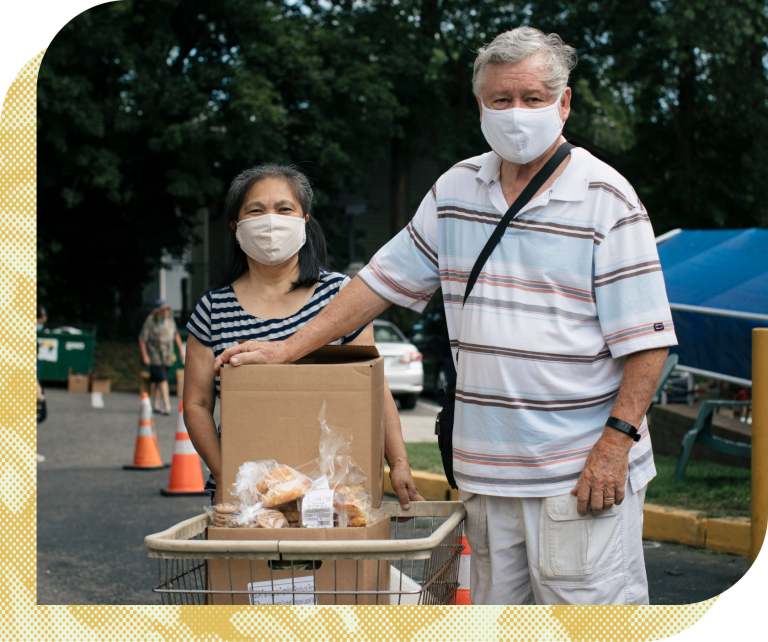
At the local level, counties can increase utilization by investing in positions that liaise between the state and local departments of health and human services and nonprofit partners, thus promoting awareness of and enrollment in social welfare programs among the eligible population. These staff can increase synergy among programs with similar eligibility requirements by implementing data-sharing agreements to identify eligible applicants, aligning public outreach efforts between programs, and recommending administrative process improvements to increase inter-programmatic utilization rates.
Expand eligibility for social safety net programs
In many cases, disadvantageous eligibility rules disqualify those with legitimate need, including lower-income working families, college students, and military families, from receiving public benefits. Several reforms to the eligibility requirements of social safety net programs would increase their reach to these households.
For example, increasing the maximum age for households with young children to receive WIC benefits from 5 to 6 would close a common gap in coverage between some children’s fifth birthday and the point of their enrollment in kindergarten. The reach and impact of The Emergency Food Assistance Program could be significantly increased by expanding eligibility, reducing barriers to access, and diversifying commodities to reflect cultural preferences. Expanding eligibility for SNAP to more college students with limited financial resources, who are generally not eligible if they are enrolled half-time or more, would help reduce food insecurity during a critical period in their lives. Eliminating the discretion to count the Basic Allowance for Housing as income when determining the eligibility of military families for SNAP or other benefits (like the Military Family Basic Needs Allowance) would protect more servicemembers and their families from food insecurity.
The cumulative effects of these reforms would be to create a strong, wide pathway for people to transition from needing a higher level of support to greater self-sufficiency and sustainability. Opportunities to expand the impact of the social safety net exist across all levels of government and have significant potential to enable more inclusive economic recovery for our region.
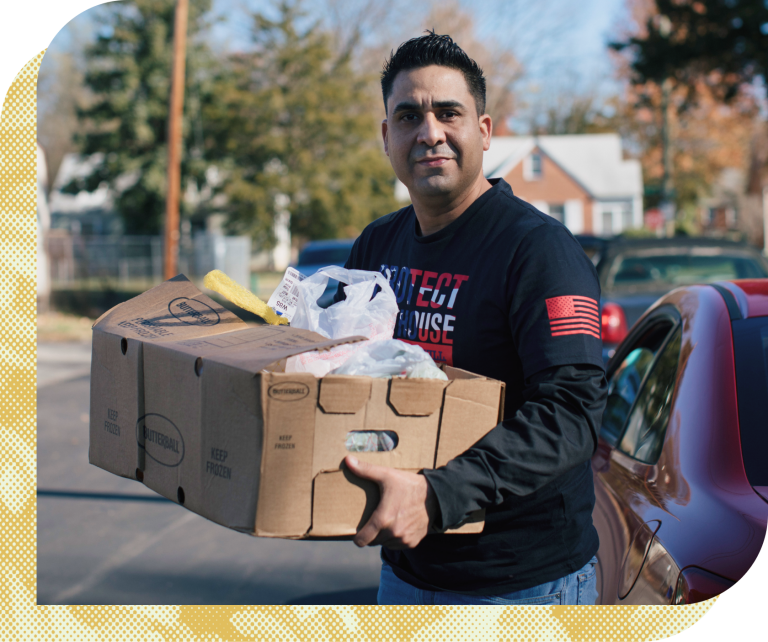
Social Sector
As addressed in this and other reports, food insecurity is rarely an isolated issue, and those who are experiencing it are often facing multiple challenges at once. Having to decide between visiting the doctor and buying nutritious groceries due to a lack of transit, for instance, can contribute to severe health problems and, in turn, make it even more difficult to consistently attend work. Such barriers have only been exacerbated by the COVID-19 pandemic, which has disproportionately affected households that were already contending with low incomes.
I'm in school and I'm working in this part time job… It was really hard trying to access the foods that we needed…
As frontline service providers, organizations in the social sector are in a unique position to meet the needs of those seeking assistance in a more holistic way by accelerating initiatives focused on greater integration of supports and new forms of collaboration. Multiple models and examples exist locally for this kind of work.
Create ease of access through service co-location
In co-location models, multiple services are provided in one place to make physical access easier. Several of the food bank’s nonprofit partners offer a version of this model on their own, providing food in addition to resources such as clothing, housing and rental assistance, furniture and housewares, counseling, and childcare at a single site. However, this model can also be particularly effective when implemented by multiple different organizations working together. In partnership with the Institute for Public Health Innovation, for instance, several nonprofits—including the food bank, Food & Friends, Metro Health, Whitman-Walker Health, and others—teamed up in the last year to provide access to COVID-19 vaccines for high-need communities at sites across the District and Prince George’s County. Working together as a network, these organizations made a critical health service easier to access by offering it at the same trusted locations where clients regularly obtain medical care, food, and other assistance.
Combine synergistic services that address both short- and long-term needs
A variation on the co-location model, combining synergistic services involves offering two or more services in one place that are intentionally combined for maximum impact. In this model, service providers leverage the unique strengths of their individual organizations to meet the immediate needs of clients, while also helping them to access services that solve challenges and create opportunities in the longer term.
The food bank has created a collection of pilot initiatives based on this concept, through which it partners with hospitals and clinics, colleges and universities, and other social service organizations. Known as Food Plus programs, these service “bundles” currently span three core areas:
- Food+Health, in which food is integrated into healthcare to promote disease prevention and management (partners include Children’s National, Potomac Health Foundation, Mary’s Center, and George Washington University). Programs are designed to improve health outcomes by enabling patients to access food and other nutrition resources right at the point of care.
- Food+Education, which pairs food and other support services for students to help improve academic outcomes and long-term financial stability (partners include Montgomery College and Northern VA community colleges). Program models currently include both onsite pantry and food delivery options to meet the needs of students and their families.
- Food+Skill Development, where food serves as an enabler for workforce development program attendance and completion by removing the burden of food costs (partners include Year Up). The program model currently includes an onsite pantry to support the nutrition needs of students who are coming in for classes.
Combined, these initiatives have reached hundreds of individuals and have strong adoption and client satisfaction rates. As more data emerges on the efficacy of each pilot and the most successful interventions are scaled, the food bank will share its learnings as part of the continued goal of accelerating movement within the sector toward more integrated, collaborative, and client-centric programming.
Explore joint program operation and administration to maximize impact
In addition to partnerships through which organizations come together to provide multiple services in one location, new models have emerged in recent years, in which nonprofit partners coordinate efforts to deliver one focused, wide-reaching program. Such initiatives involve high levels of collaboration and represent new ways for organizations to work together within the social sector.
New forms of collaboration create opportunities for generating maximum impact through joint ownership of a shared goal.
THRIVE East of the River is an example of this kind of multi-organization partnership. Developed during the height of the pandemic, the THRIVE pilot provided emergency cash relief of $5,500, in addition to other services such as weekly groceries and assistance securing resources like unemployment insurance, financial literacy training, mental health support, and, upon request, workforce training. The program was a partnership between Bread for the City, the Far Southeast Family Strengthening Collaborative, Martha’s Table, and the 11th Street Bridge Park (a project of the Ward 8 nonprofit Building Bridges Across the River).
The initiative reached almost 600 participants in Washington, DC. Most were Black, had low incomes, and lived in neighborhoods east of the Anacostia River. Among other outcomes, participants reported substantially better mental health and lower rates of food insecurity than other people with low incomes, both nationally and in DC, after receiving the cash payments.
These new forms of collaboration create opportunities for generating maximum impact through joint ownership of a shared goal. Such partnerships, while possibly more complex at various phases, hold the potential to open up new kinds of service and create outcomes for clients that no single organization could achieve on its own.
This type of program innovation also presents new ways—through joint fundraising or pursuing other novel funding approaches—for nonprofits to think about working with philanthropic partners that are looking to invest in creative solutions built on the collective strengths and reach of all partners involved.
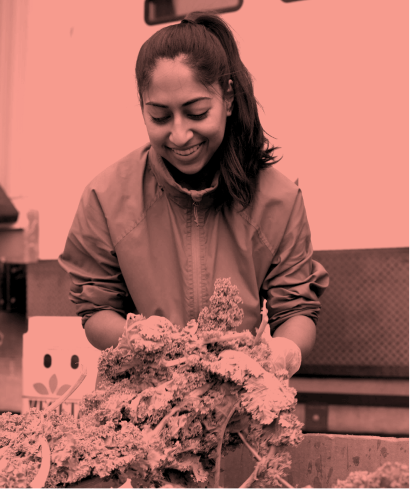

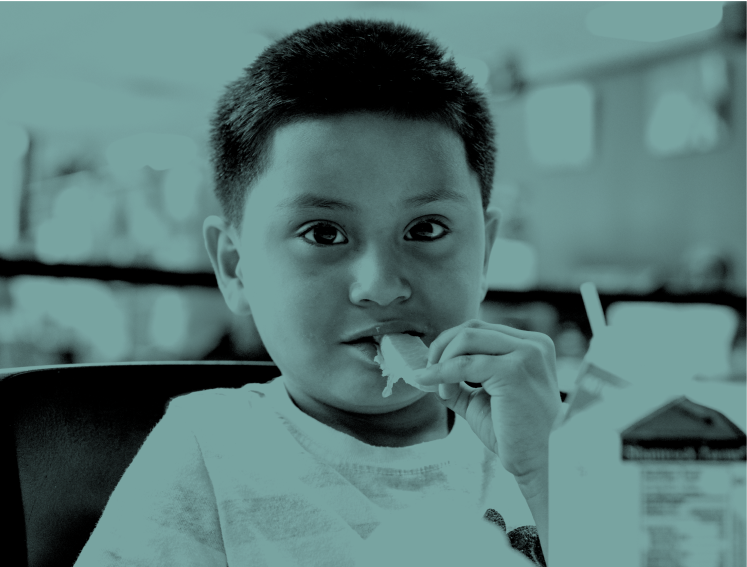

Conclusion
With COVID-19 once more appearing to recede, we must now fully assess what is left in its wake. Alongside its toll on human life, the pandemic’s effect on the financial futures of our neighbors has been profound, and even with the health crisis seeming to wane in our region, its lasting impacts will reach far into the future.
The data are clear: inequity has grown, and the valley between the realities of those at different income levels is set to continue widening. These divides negatively impact not only the increased numbers of people at the lower end of the socioeconomic spectrum who have experienced food insecurity or economic instability—they have negative ripple effects that impact the entirety of our economy, and the whole of society.
For many, the pandemic has made these issues impossible to ignore, and several promising initiatives are underway to change our current course. What is needed now is the growth and acceleration of these efforts that not only matches but exceeds the rate at which inequity is expanding.
Building an inclusive recovery will be far more challenging than simply returning to pre-pandemic norms. It will demand transformational and intentional changes across every sector, as well as new levels of coordination and partnership. But to fulfill the true potential of our region, now and for future generations, it is the only path. Together we can —and must—create a new way forward.